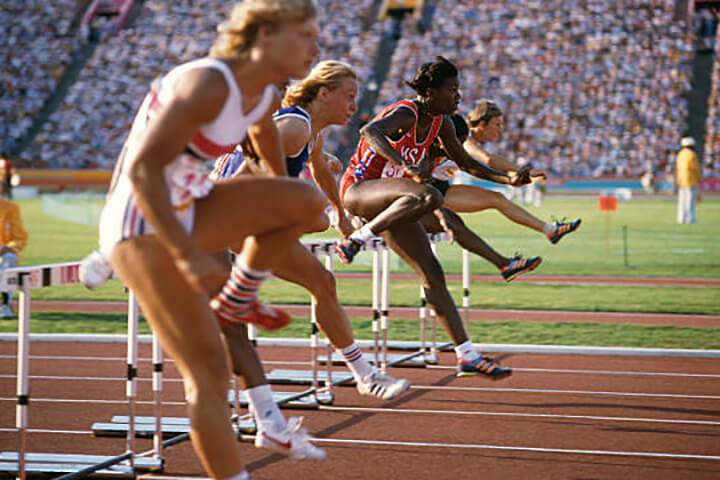By Benita Fitzgerald Mosley | Olympic Gold Medalist and CEO, Laureus Sport for Good Foundation USA

Run your own race. That's one of the lessons I learned on the track - reiterated consistently by coaches at every level of athletic career - that helped me clear the 100-meter hurdles with world-class speed.
The 100-meter hurdles is a rhythmic event. Everyone takes eight steps to the first hurdle and three steps in between each of the 10; then, it's a made dash to the finish line. It's easy to get into another competitor's rhythm, and when that happens, the race can be close. And close it was at the 1984 U.S. Olympic Track and Field Team Trials, where only the top three finishers in each event make the U.S. Olympic team.
Photo Finish

The '84 trials were held in the LA Coliseum. There were eight of us in the final. Organizers drew lanes, and the top four competitors ended up on opposite sides of the track, in lanes 1,2, 7 and 8. The four of us sprinted ahead of the rest of the field by the first or second hurdle. For the rest of the race, we each focused our attention on the person in the lane beside us and ran in sync instead of focusing on our own race. The winning time was almost half a second slower than each of our personal bests, which is a century in sprint time. At the finish, 1/100th of a second separated us, which at the time was considered the closest race in modern track and field history. Thankfully, I ended up placing second and made my second Olympic team.
At the Los Angeles Olympic Games later that summer, I made sure to head my coaches' advice: Concentrate on your own lane and your own pace, and don't be distracted by what your competitors are doing. I powered down the track with my eyes focused on crossing the finish line first, running the length of a football field over 10 hurdles in 12 seconds. I ran my own race and was blessed to win a gold medal.
Tunnel Vision
Sometimes in our careers and everyday lives, we must have tunnel vision. We need to put blinders on to eliminate distractions, naysayers and criticism so that we can focus on our passion, strengths and goals. Everyone has their own unique career path, and you can't let others' expectations define you, slow you down or determine how you should navigate your professional path.
Throughout my career, I've moved from athlete to engineer; defense contractor to cable industry executive; from for-profit to non-profit companies; from organizations focused on people with disabilities, to gender diversity, to Olympic performance and now to sports-based youth development; and from CEO to No.2 and back to CEO again.

A Career 'Lattice'
I call my career path a career lattice instead of a career ladder. I've moved from opportunity to opportunity, driven by my desire to be challenged, to apply my experience and expertise to advance mission-driven organizations, and to help others achieve gold medals in their on lives and careers.
The late Katherine Graham, former CEO of The Washington Post Co. and former publisher of The Washington Post, once said, "To love what you do and feel that it matters - how could anything be more fun?" We were put on this earth for our own unique purpose, not to run in sync with someone else or to pursue someone else's dreams. The only way you can fulfill your purpose, set your own path and achieve your goals in life and career is to heed my coaches' advice, too, and run your own race.

About Benita Fitzgerald Mosley
Benita Fitzgerald Mosley is chief executive officer of the Laureus Sport for Good Foundation USA. Prior to joining Laureus USA, Fitzgerald Mosley was chief of organizational excellence for the United States Olympic Committee. Named a SportsBusiness Journal Game Changer in 2015, she led USA Track & Field's 2012 Olympic team to 29 medals, its best performance in 20 years, as chief of sport performance. She was president and CEO of Women in Cable Telecommunications for eight years, during which time TelevisionWeek magazine honored her as Cable TV Executive of the Year. Her passion for sports includes her participation on the 1980 and 1984 Olympic teams and winning a gold medal in the 100-meter hurdles at the Los Angeles Olympic Games.
The opinions expressed are those of the author(s) alone, and do not necessarily reflect the views and opinions of WISE or any employees or affiliates. WISE makes no representation as to the accuracy, completeness, validity, or usefulness of any of the information supplied by the author(s). WISE will not be liable for any errors or omissions in the information or any losses, injuries or damages arising from its use. Publication of the information should not be considered endorsement by WISE. By using this website, you accept this disclaimer in full.
#ThoughtLeadership#Slideshow